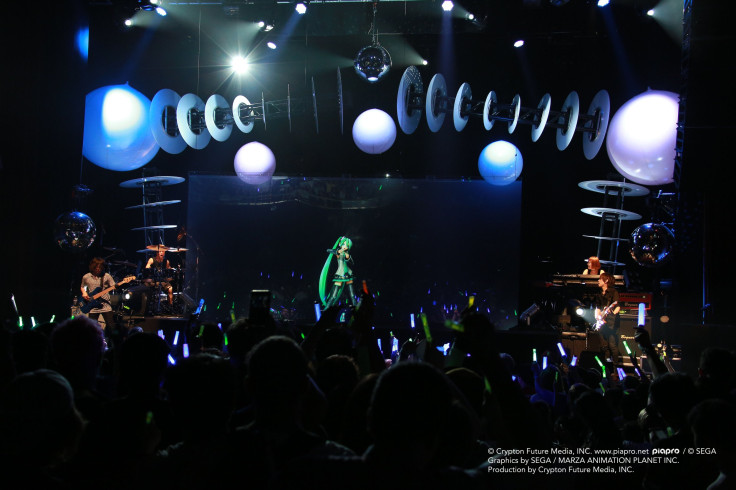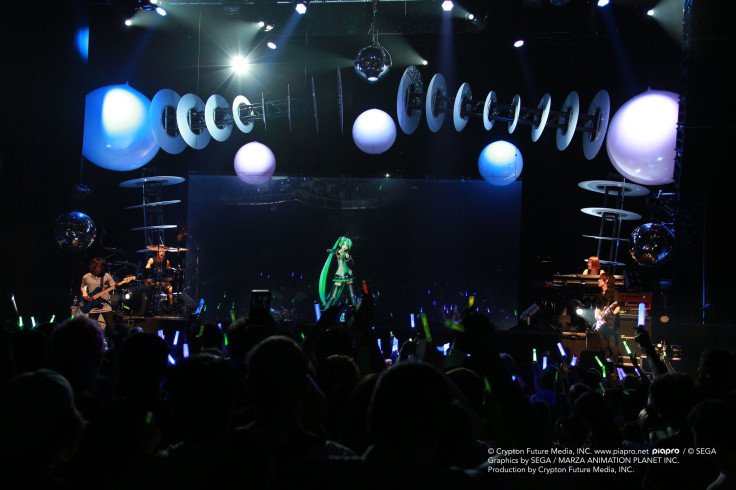Japanese Pop Star Hatsune Miku Is Taking Over America — Never Mind That She’s Not Human

Digital pop singer Hatsune Miku, who stands a towering 5-foot-2 and whose name translates to “the first sound of the future,” headlined two recent shows at New York’s Hammerstein Ballroom as part of a 10-city tour. It's Miku's most extensive North American tour yet, and it solidifies her star status — even if she's not human.
While the average pop star these days can sometimes seem plastic, Miku really is manufactured; she's literally a projection. And yet real, human fans around the world pay anywhere from $60 to $150 to see her perform. In fact, Miku's advantage over Beyoncé or Taylor Swift is that she is an open-sourced, communal creation whose very appearance upon large stages reinforces her popularity.
The heart of Miku is a synthesized vocal application developed in 2007 by Crypton Future Media, a media company headquartered in Sapporo, Japan. Dubbed vocaloids, the processed human voice can be used by any fan or producer to create music. Miku is similar to an instrument or the GarageBand program. A user or producer can download the Miku program and begin making songs. After they created a song, they could upload the track to a social media platform where it can be shared with other fans around the world. Crypton has also created five other vocaloid programs that producers can use to create music.
It wasn't until Crypton created the Miku character that her popularity exploded into a global phenomenon. Manga artist Kei designed Miku by following the traditional tenets of anime. Very simple lines, a facial structure created using a few strokes and a body designed to emphasize proportions. Miku has impossibly long arms and legs to the point where she's the world's tallest short person. The turquoise pigtails, a nod to Yamaha's synthesizers, became the defining characteristic of Miku. Crypton would begin marketing Miku to the U.S. in 2011 with an official English release of the program in 2013.
“That’s what fans of anime and manga like, this over-the-top use of the medium of illustration to create an idealized, dream-world character,” Roland Kelts, author of “Japanamerica,” told International Business Times.
Miku, in some ways, is a culmination of Japan’s cultural embrace of anime with the digital tools that let them go even further in their fandom. Doujin culture, or fan art culture, is one such example of how fans have become unofficial creators in their own right, according to Kelts. The Comic Market, or Comiket, which takes place twice a year in Japan, brings in over 500,000 people in the summer and winter.
At Hammerstein Ballroom, Miku's fans were actively participating in the concert with a sea of color-changing glowsticks waved in coordinated movements throughout the night. Some fans were prepared with sticks that match the song’s motif. “Deep Sea Girl” was met by blue, whereas the appearances of the Kagamine twins were met with yellow.
Starting off with her most popular song, "World Is Mine," Miku towered over the crowd, her image on the large screen flanked by talented musicians. Behind the scenes, a team of top programmers were making sure Miku's pre-programmed performance was going as planned. Computer programs are not infallible, as anyone whose computer has ever crashed during an important presentation knows.
For those in attendance, it had less to do with any particular musical style and more to do with Miku herself. Her music comprises all the genres: From high-energy pop songs, where Miku’s singing races by at a clip that’s humanly impossible, to slower ballads, to heavy rock numbers, to EDM with a bass drop for good measure, Miku’s concert is a genre-defying experience. Over two hours, there were frequent costume changes — including a heavy metal guitar to angel wings — along with cameo appearances from her pre-programmed friends. The highly crafted experience served as a greatest hits rundown for Miku.
At any concert, the crowd can make or break a performance, with great experiences made even better by raucous fans. It’s this communal aspect that get people to concerts in the first place, but to share that experience at a Miku concert is different because everyone is already involved in her creation. She, as an artist, is not making the music. Her appearance is dictated by designers and programmers. Miku is a social creation that’s shared, uploaded and spread around the world.

Miku songs were first shared on Nico Nico Douga, a Japanese equivalent of YouTube, shortly after her release in 2007, which created a creative feedback loop that led to illustrations, animations and mashups to be uploaded onto the site. More fans were drawn to Miku, but also to the varied interpretations of Miku. Songs went viral and producers became popular figures in their own right. Wowaka, Ryo, Hachioji-P and kz are just a few mega Miku producers whose songs and albums have topped the Japanese charts.
While the community is more robust on Nico Nico, YouTube is an important gateway to the vocaloid community. Fans can post videos or provide translations to popular songs. “There's an argument to be made that Miku could not have happened without the contemporary intersection of strongly connected interest-based online communities, infrastructure for social media platforms, and a particular moment in pop culture interests [anime fandom in the late 1990s/early 2000s],” said Alex Leavitt, PhD, a researcher at the Annenberg School for Communication & Journalism at the University of Southern California.
Miku is the perfect pop star for a generation growing up with social platforms to express every whim or action on a daily — or by minute — basis. One survey had 51 percent of millennials saying they were mostly or always online and connected. Another survey from the Pew Research Center had 36 percent of adults between the ages of 18 and 29 saying they were online almost constantly.
Facebook, Twitter, Snapchat and any other conceivable social channel gives the users a forum for expression. Celebrities have capitalized on social media to engage with fans, but also further their own identities as "#brands." Except with the likes of Swift or Kim Kardashian, that's a one-way transaction heavily in favor of the celebrity. When the celebrity is the social platform itself, that's when things get really interesting.
Fan were no longer being affected by a superstar from afar; they were actually creating the celebrity. “The vocaloid character known as Miku hits a lot of buttons in our zeitgeist. On the one hand, it's a user generated content platform. And, in some ways, it's a pop singing Facebook, Twitter or Instagram,” said Kelts.
Miku, as an instrument, opens up many creative opportunities for a producer. Hachioji-P, who has two songs featured on this tour, can use her vocals to create new melodies and arrangements. Unlike his experience working with different bands and singers, Hachioji-P told IBT he can use Miku to explore high-pitch ranges or a long stretch of singing where Miku does not have to take a breath. Hachioji-P joked, “Hatsune Miku is my favorite partner!”
Exporting Miku to the West was made easier by our comfort with social media. “There are global fans now, because of all these sites, everybody’s using these platforms to post their own content and Miku is just an extension of that with music,” Kelts said.
The global Miku community has been aided by Crypton's hands-off approach to its creation. “What’s so fascinating is the way it starts as a community,” said Ian Condry, cultural anthropologist at MIT and author of “The Soul of Anime.” “Because it started with a rather unique relationship to copyright, it opened up this world of creativity that later enabled growth of business around it.”
By giving access to Miku, Crypton has ensured their creation is an integral part of the cultural consciousness. There are along the lines of 100,000 songs featuring Miku with many creations inspired by that music. The awareness means Miku can go on an overseas tour where tickets and merchandise can be sold. Miku has performed on the "Late Show with David Letterman," supported Lady Gaga on tour, collaborated with Pharrell, appeared as a spokeswoman for Toyota, featured in an LG commercial with Jason Statham and appeared in her own video games.
Every Miku song that's out there is owned by the respective producers. If Crypton wants to use a particularly popular song, Crypton must license the track from the producer. Whether it's for a video game, or North American tour, Crypton pays a royalty for these songs. It's communal in nature because these songs achieved popularity by going viral on a site such as Nico Nico, which is driven by the number of views a video received.
“Crypton has been more open about letting people use the character and not charging for it. What it shows is that by loosening up copyright, you can encourage a blossoming of creativity that can then turn into all sorts of businesses,” Condry said.
It’s a lesson that the music industry reluctantly learned after resisting the demand for digital distribution. Streaming has become the new norm, with streams now counting for placement on the Billboard charts. “Now the power is really on the side of the consumer,” Condry said. “It’s up to the musicians, and the companies supporting the musicians, to move beyond the recording model of making money and into other models that build on the energy and excitement of a community of fans.”
After a North American tour that saw Miku perform in Los Angeles and New York, Crypton received feedback that there was a large enough audience to sustain such a big production, according to Kanae Muraki, director of global development at Crypton Future Media. The Hatsune Miku Expo 2016 held shows in Toronto, seven U.S. cities as well as Monterrey, Mexico, and Mexico City. Each concert is expensive to put on, as most of the key elements of the show have to be flown in from Japan, including the Miku screen. “Fans have been waiting for years to see Miku,” said Muraki. She describes Crypton as a curator in the world of Miku. Crypton has to license every song performed at the concert along with fan-created artwork featured as merchandise or prominently displayed at events around each concert.
Creators benefit greatly with the worldwide expansion of Miku. Hachioji-P is headlining a club night in Brooklyn as part of the Miku Expo the night before the Hammerstein Ballroom concerts. When he uploaded a new video to YouTube, Hachioji-P said he received so many comments in English because of his work with Miku.
As a business, Miku has successfully invaded North America, with strong communities in Mexico and Brazil, according to Muraki. Europe is still an untapped market that is being researched by Crypton for a future concert. Outside of Japan, China and Taiwan are among the biggest markets for Miku. “Any country with a young population who is really active on the Internet, there’s an audience,” Muraki said.
Saturday's concert ended with “Star Fragment,” a Miku solo performance. As a moment for the audience to reflect, the Miku concert is the summation of the vocal community. A social creation shared digitally to, finally, be shared in the real world. “Here’s a completely fan-made artifact where some of the top producers in the Miku world can see their work on stage," Condry said. "But it also shows that their fan creativity has led to something.”
© Copyright IBTimes 2025. All rights reserved.






















